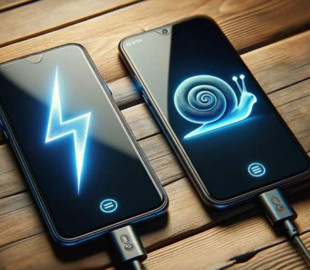
Charging a smartphone, although it seems like a simple process, has its subtleties that help extend the life of the battery and preserve its maximum capacity. Let's take a closer look at this issue.
Deep Charge and Discharge
One of the key recommendations from experts is to avoid deep charge and discharge cycles. Lithium-ion batteries used in modern smartphones work most efficiently within certain limits of charge and discharge.
Optimal range – 20%-80%
The best range for charging and discharging is considered to be between 20% and 80% charge level. It is recommended not to discharge the smartphone below 20%, and to charge it above 80%.
This approach helps avoid deep charge and discharge cycles, which can lead to rapid battery wear and reduced capacity. Each complete charge and discharge cycle is considered one cycle, and lithium-ion batteries retain about 80% of their capacity after 500 such cycles. Some smartphone models are also able to remember the number of charge-discharge cycles, which can lead to an artificial decrease in their capacity.
Why is this important?
Full charge 100%
strong>
Charging the battery to 100% each time is treated as one full cycle, which can accelerate battery wear. When a battery is charged to its maximum value, it is subjected to additional voltage, which can cause redox reactions and increase internal resistance, which eventually reduces its capacity. In addition, the phone “wobbles” during charging. between charge and discharge, which also negatively affects the battery.
Full discharge 0%
200% Deposit Bonus up to €3,000 180% First Deposit Bonus up to $20,000Similarly, deep battery discharge to 0% is also harmful. This can lead to the fact that the battery “doesn't like” full discharge. There are cases when a completely discharged smartphone refused to charge — the controller determined that the battery failed (especially relevant for old models).
Alternative tactics – 50%-70%
For longer battery life, there is an alternative – “50-70” charging tactics. It involves maintaining the charge level between 50% and 70%. This approach can significantly extend battery life, but requires more frequent charging throughout the day.
Frequent charging
Charge your phone more often, in short sessions, instead of one long charge. This helps avoid deep cycles and reduces battery wear. When a low battery warning appears (usually between 15-20%), it is recommended to charge the device instead of waiting for it to fully discharge.
Special features and capabilities
Many modern smartphones have built-in functions to optimize battery charging. For example, the iPhone has the function “Optimized charging”; (in the "Settings" section – "Battery" – "Battery status and charging"), and Samsung has the function "Battery protection" (in the section “Settings” – "Device maintenance" – "Battery"). Most operating systems also offer features to track battery health.
In addition, there are special applications, such as Battery Charge Limit, which notify the user when a certain charge level is reached, allowing the recommended charging cycles to be followed.
The influence of temperature
It is equally important to control the temperature of the device. High or low temperatures can negatively affect battery life. Regularly rebooting the smartphone and calibrating the battery also help to maintain its health and efficiency. Do not charge the smartphone if it is cold or overheated.

